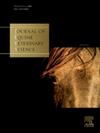Prediction of breeding soundness in pre-, peri- and postpubertal colts
IF 1.3
3区 农林科学
Q2 VETERINARY SCIENCES
引用次数: 0
Abstract
Prediction of future fertility is important for stallion breeders as rearing of colts for breeding purposes is expensive. Thus, the study examined the testicular development and hormonal profiles in a group of pre-, peri- and postpubertal Warmblood colts (n=46) and evaluated the fertility of selected stallions (n=12) at 2.5 years of age, aiming to find parameters for predicting the breeding soundness at the youngest possible age. Exams were performed at 177±23, 604±23 and 894±24 days of age and included body condition scoring and weighing, examination of the testes (palpation, ultrasound, volume determination) and blood sampling (before and after stimulation with hCG (5000 I.U., i.v.). Hormone analysis included determination of AMH (basal) and testosterone (at 0, 2, 24 and 72 h after stimulation). Stallions with abnormal (n=6) and normal (n=6) were subjected to spermatological examination. During the examination period, palpatory findings were inconsistent in individual colts and testicular volume increased gradually with age. Body mass was 455±38 kg for peripubertal (BCS: 5.17±1.02) and 526±40 kg for postpubertal stallions (BCS: 5.26±0.94). Stallions (n=12) were grouped according to their total testicular volume (small vs. normal) and palpatory findings (abnormal vs. normal) at 2.5 years of age (937±21 days). No significant differences were observed for the total number of morphologically normal, progressively motile spermatozoa for different stallion groups, but more progressively motile spermatozoa (PMS) were observed after storage for 24 h in a centrifuged extended semen sample (p<0.05). Flowcytometric analysis revealed a lower percentage of membrane intact spermatozoa after incubation with Ca-ionophore for 120 min in stallions with small testes, while the percentage of acrosome reacted spermatozoa was higher in this group. A positive correlation of BCS and PMS was found (extended sample: r=0.765, centrifuged sample: 0.699, p<0.05). Analysis of AMH plasma concentrations showed no differences between abnormal or small testes irrespective of age group. AMH concentration was significantly higher in peripubertal colts as compared to younger and older animals. hCG stimulation affected testosterone in all age groups and resulted in the strongest increase in postpubertal stallions 72 h after administration. Based on the evaluated parameters in pre- and peripubertal colts, no prediction of sperm quality at 2.5 years of age was possible. Moreover, inconsistency in palpatory findings (except for cryptorchism) and testicular size for individual colts at 0.5 and 1.5 years of age renders early prediction of breeding soundness in stallions impossible. The results demonstrate, however, an influence of the BCS on sperm quality in postpubertal colts.
预估青春期前、青春期前后和青春期后的小马的繁殖状况
预测未来的生育能力对种马饲养者来说是很重要的,因为为了繁殖目的而饲养小马是很昂贵的。因此,本研究检测了一组温血小马(n=46)青春期前、青春期前后和青春期后的睾丸发育和激素特征,并评估了选择的种马(n=12)在2.5岁时的生育能力,旨在找到在尽可能小的年龄预测育种健康的参数。检查分别在177±23、604±23和894±24日龄进行,包括身体状况评分和称重、睾丸检查(触诊、超声、体积测定)和血液采集(hCG刺激(5000 iu, i.v)前后)。激素分析包括AMH(基础)和睾酮(刺激后0、2、24和72 h)的测定。对正常种马(n=6)和异常种马(n=6)进行精子学检查。在检查期间,个别小马的触诊结果不一致,睾丸体积随着年龄的增长而逐渐增加。发育期公马体质量为455±38 kg (BCS: 5.17±1.02),发育期公马体质量为526±40 kg (BCS: 5.26±0.94)。根据2.5岁(937±21日龄)时的睾丸总体积(小与正常)和触诊结果(异常与正常)对12匹公马进行分组。不同种马组形态正常、进行性运动的精子总数差异不显著,但在离心延长的精液样品中保存24 h后,进行性运动的精子(PMS)增加(p < 0.05)。流式细胞术分析显示,小睾丸种在与钙离子载体孵育120 min后,精子膜完整的百分比较低,顶体反应的百分比较高。BCS与PMS呈正相关(扩展样品:r=0.765,离心样品:0.699,p<0.05)。AMH血浆浓度分析显示,在不同年龄组的异常或小睾丸之间没有差异。与较年轻和较年长的动物相比,处于青春期的小马的AMH浓度明显较高。hCG刺激影响了所有年龄组的睾酮,并在给药后72小时导致青春期后种马的睾酮增加最多。基于预发育期和围发育期小马的评估参数,无法预测2.5岁时的精子质量。此外,在0.5岁和1.5岁的小马个体中,触诊结果(除隐睾外)和睾丸大小的不一致使得对种马繁殖健康的早期预测变得不可能。然而,结果表明,BCS对青春期后小马的精子质量有影响。
本文章由计算机程序翻译,如有差异,请以英文原文为准。
求助全文
约1分钟内获得全文
求助全文
来源期刊

Journal of Equine Veterinary Science
农林科学-兽医学
CiteScore
2.70
自引率
7.70%
发文量
249
审稿时长
77 days
期刊介绍:
Journal of Equine Veterinary Science (JEVS) is an international publication designed for the practicing equine veterinarian, equine researcher, and other equine health care specialist. Published monthly, each issue of JEVS includes original research, reviews, case reports, short communications, and clinical techniques from leaders in the equine veterinary field, covering such topics as laminitis, reproduction, infectious disease, parasitology, behavior, podology, internal medicine, surgery and nutrition.
 求助内容:
求助内容: 应助结果提醒方式:
应助结果提醒方式:


